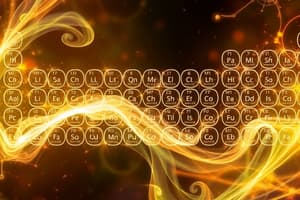Podcast
Questions and Answers
How many neutrons does an isotope of an element with a mass number of 25, containing 13 protons, have?
How many neutrons does an isotope of an element with a mass number of 25, containing 13 protons, have?
12
Which of the following could be a possible identity for X, where the atomic radius is larger than aluminum?
Which of the following could be a possible identity for X, where the atomic radius is larger than aluminum?
argon, Ar
Are Isotope X and Isotope Y different elements? Explain why or why not.
Are Isotope X and Isotope Y different elements? Explain why or why not.
No, they are not different elements because they have the same number of protons.
Do Isotope X and Isotope Y have the same atomic mass? Explain why or why not.
Do Isotope X and Isotope Y have the same atomic mass? Explain why or why not.
Do Isotope X and Isotope Y have the same number of valence electrons? Explain why or why not.
Do Isotope X and Isotope Y have the same number of valence electrons? Explain why or why not.
Which of the following is the correct Lewis structure for oxygen? In the molecule shown, the central atom forms bonds to _____ atoms and has ____ lone pairs.
Which of the following is the correct Lewis structure for oxygen? In the molecule shown, the central atom forms bonds to _____ atoms and has ____ lone pairs.
Compared to the bromate ion, the hypobromite ion would have One more oxygen atom, the same number of oxygen atoms, one less oxygen atom, or two less oxygen atoms?
Compared to the bromate ion, the hypobromite ion would have One more oxygen atom, the same number of oxygen atoms, one less oxygen atom, or two less oxygen atoms?
Based on electronegativity, which of the following would have only ionic bonds? silicon tetrafluoride, carbon monoxide, nitrogen dioxide, or hydrogen sulfide?
Based on electronegativity, which of the following would have only ionic bonds? silicon tetrafluoride, carbon monoxide, nitrogen dioxide, or hydrogen sulfide?
For a carbon-nitrogen bond, you would expect A partial negative charge on the carbon, a partial positive charge on the nitrogen, both a and b, or none of these?
For a carbon-nitrogen bond, you would expect A partial negative charge on the carbon, a partial positive charge on the nitrogen, both a and b, or none of these?
Which of the following compounds is a hydride? KOH, HCl, AlH3, or HNO3?
Which of the following compounds is a hydride? KOH, HCl, AlH3, or HNO3?
Flashcards are hidden until you start studying
Study Notes
Isotopes and Neutrons
- An isotope with a mass number of 25 and 13 protons has 12 neutrons (25 - 13).
- Isotopes differ in neutron number but are the same element; thus, Isotope X (16 protons, 16 neutrons) and Isotope Y (16 protons, 18 neutrons) are different isotopes of the same element.
Atomic Radius Comparisons
- An element X has a larger atomic radius than aluminum; possible identities for X include magnesium (Mg) or potentially aluminum ion (Al3+).
- Argon (Ar) and boron (B) cannot have a larger atomic radius than aluminum.
Lewis Structures
- The correct Lewis structure for oxygen indicates it forms two bonds and has two lone pairs.
Ion Comparison
- The hypobromite ion has one less oxygen atom compared to the bromate ion.
Electronegativity and Bonding
- Ionic bonds typically occur when there is a significant difference in electronegativity; silicon tetrafluoride, carbon monoxide, nitrogen dioxide, and hydrogen sulfide are evaluated for bond type.
- In a carbon-nitrogen bond, expect a partial negative charge on carbon and a partial positive charge on nitrogen due to differences in electronegativity.
Hydrides
- Among listed compounds, AlH3 (aluminum hydride) qualifies as a hydride.
Bond Characteristics
- In non-polar bonds, electrons are shared equally between atoms, contrary to polar bonds where electrons are shared unequally or transferred.
Molecular Shapes
- The molecule SCl2 exhibits a bent molecular shape, while CO2 is linear, and PH3, though not specified to be bent, may have a different arrangement based on lone pairs.
Studying That Suits You
Use AI to generate personalized quizzes and flashcards to suit your learning preferences.




